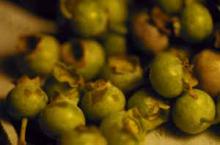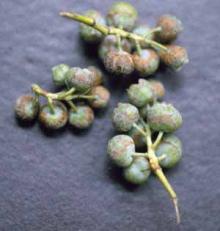Cause Fruit russeting has been observed with late treatments of chlorothalonil products (Bravo and maybe Echo), Regalia, or triforine (Funginex) at high rates. The russeting can resemble cold injury to fruit. Injury from Bravo is more common when air temperatures are high. The cultivar Bluetta was very susceptible to chemical injury of leaves during 2002 disease control trials in western Oregon.
The nonionic spreader sticker Cohere was implicated in leaf, flower and fruit damage in North Carolina. Fields in New Jersey treated with Prowl H2O (pendimethalin) in 2017 developed short internodes, fruit with equatorial russeting and root damage.
Symptoms Fruit develop small, roughened areas after bloom that are reddish-brown. These diffuse areas looked netted and slightly raised. Berries may crack or split close to harvest.
Control Do not use these fungicides during late bloom stages.
References Pscheidt, J. W., and Kenyon, G. 2002. Fungicide control of blueberry ripe rot (anthracnose), 2002. F&N Tests 58:SMF054.
Pscheidt, J. W., Bassinette, J. P., and Florence, J. 2014. Evaluation of various products for management of mummy berry, 2013. PDMR 8:SMF003.
Besançon, T. E., Ward, D. L., Oudemans, P. V., and Pavlis, G. C. 2020. Grower Records and Logistic Regression to Solve Production Problems in Highbush Blueberry. Plant Health Progress, 21:180-184.



